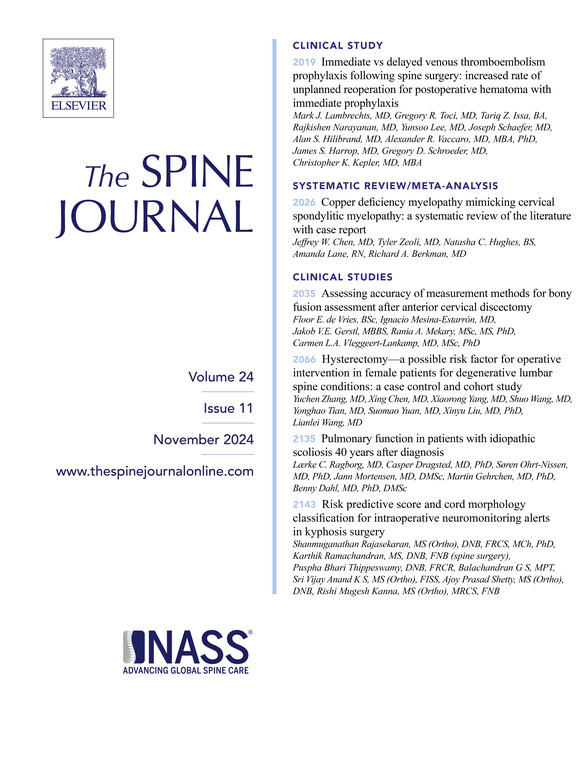Redefining Oswestry Disability Index success criteria to assess the effect of consecutive surgeries on lumbar spinal stenosis
IF 4.9
1区 医学
Q1 CLINICAL NEUROLOGY
引用次数: 0
Abstract
BACKGROUND
Register studies have shown that chances of success after surgery for lumbar spinal stenosis (LSS) decrease with increasing numbers of previous operations. However, these studies presumed that success criteria remain constant with each consecutive spinal surgery.
PURPOSE
We aimed to redefine success criteria specific for each consecutive surgery. Also, we assessed if fusion could be an effective procedure for LSS patients with previous decompression(s).
STUDY DESIGN
We retrospectively analyzed prospectively collected patient-reported outcome measures (PROMs) from surgically treated LSS patients enrolled in The NORspine Register.
PATIENT SAMPLE
Patients operated for lumbar spinal stenosis.
OUTCOME MEASURES
PROMs: Oswestry Disability Index (ODI) percentage (%) change and Global Perceived Effect (GPE).
METHODS
We categorized the LSS cohort by number of previous spine surgeries (none to ≥3). ROC analyses gave the most accurate cut-offs for ODI% change that corresponded to success, anchored by GPE, ie, “much improved” and “completely recovered”. Areas under the ROC curves (AUCs) indicated how well ODI discriminated between success and nonsuccess for each consecutive surgery: good (0.8–0.89) and excellent (0.9–0.99). We then calculated proportions of successfully treated patients by number of consecutive surgeries. We also analyzed whether fusion succeeded in patients with previous lumbar decompression(s).
RESULTS
At 12 months, 8,919 (75%) responded; 6,961 (78%) had no previous LSS surgery, 1,338 (15%) had one, 417 (5%) had 2, and 203 (2%) had ≥3 previous surgeries. Preoperative ODI (95% CI) was 38.7 (38.2–39.1) for no previous surgery versus 49.4 (46.9–51.9) for patients with ≥3 previous surgeries. The postoperative ODIs (95% CI) were 21.9 (21.4–22.4) and 37.9 (34.9–40.8) for patients with no and ≥3 previous surgeries, respectively.
For patients with no previous surgeries, ODI% change of 37.6% most accurately defined success (AUC [95% CI]=0.909 [0.903–0.916]), and 57.1% reported success. For patients with ≥3 previous surgeries, success was an ODI% change of 25.0% (AUC [95%CI]=0.930 [0.890–0.971]), and 46.3% reported success.
Finally, 350 patients received fusion after previous decompression(s). ODI% change of 34.6% defined success (AUC [95% CI]=0.920 [0.890–0.949]). The proportion of successfully treated fusion patients was 47.7%, compared to 54.3% for the entire cohort.
CONCLUSIONS
We redefined ODI success criteria for patients with consecutive lumbar spinal stenosis surgeries. Our register study found the detrimental effect of consecutive surgeries on success rates to be less pessimistic than previously reported; fusion may be an effective option for LSS patients with previous decompression.
重新定义 Oswestry 失能指数成功标准,评估腰椎管狭窄症连续手术的效果。
背景:注册研究表明,腰椎管狭窄症(LSS)手术后的成功几率随着手术次数的增加而降低。目的:我们旨在重新定义每次连续手术的成功标准。研究设计:我们回顾性分析了前瞻性收集的患者报告结果指标(PROMs),这些指标来自于NORspine登记处登记的接受过手术治疗的LSS患者:患者样本:接受腰椎管狭窄手术的患者:PROMs:结果测量:PROMs:Oswestry残疾指数(ODI)百分比(%)变化和全球感知效果(GPE):我们按照既往脊柱手术次数(无至≥3次)对LSS队列进行了分类。ROC分析给出了与成功相对应的ODI%变化最准确的临界值,以GPE为基础,即 "大为改善 "和 "完全康复"。ROC 曲线下面积(AUC)显示了每次连续手术的 ODI 对成功与否的区分度:良好(0.8-0.89)和优秀(0.9-0.99)。然后,我们按连续手术次数计算成功治疗患者的比例。我们还分析了曾接受过腰椎减压术的患者是否成功接受了融合手术:12个月后,8919人(75%)做出了回应;6961人(78%)既往未接受过LSS手术,1338人(15%)接受过一次手术,417人(5%)接受过两次手术,203人(2%)接受过≥3次手术。既往未接受过手术的患者术前 ODI(95%CI)为 38.7(38.2-39.1),而既往接受过≥3 次手术的患者为 49.4(46.9-51.9)。既往未接受过手术和接受过≥3次手术的患者的术后ODI(95%CI)分别为21.9(21.4-22.4)和37.9(34.9-40.8)。对于既往未接受过手术的患者,37.6%的ODI变化最准确地定义了成功(AUC(95% CI)=0.909 (0.903-0.916)),57.1%的患者报告成功。对于既往接受过≥3次手术的患者,成功的定义是ODI%变化为25.0%(AUC(95%CI)=0.930 (0.890-0.971)),46.3%的患者报告成功。最后,350 名患者在接受减压术后接受了融合术。ODI变化率为34.6%(AUC(95%CI)=0.920 (0.890-0.949))。成功治疗的融合患者比例为47.7%,而整个队列的比例为54.3%:我们重新定义了腰椎管狭窄症连续手术患者的ODI成功标准。我们的登记研究发现,连续手术对成功率的不利影响没有之前报道的那么悲观;对于之前接受过减压手术的腰椎管狭窄症患者来说,融合术可能是一种有效的选择。
本文章由计算机程序翻译,如有差异,请以英文原文为准。
求助全文
约1分钟内获得全文
求助全文
来源期刊

Spine Journal
医学-临床神经学
CiteScore
8.20
自引率
6.70%
发文量
680
审稿时长
13.1 weeks
期刊介绍:
The Spine Journal, the official journal of the North American Spine Society, is an international and multidisciplinary journal that publishes original, peer-reviewed articles on research and treatment related to the spine and spine care, including basic science and clinical investigations. It is a condition of publication that manuscripts submitted to The Spine Journal have not been published, and will not be simultaneously submitted or published elsewhere. The Spine Journal also publishes major reviews of specific topics by acknowledged authorities, technical notes, teaching editorials, and other special features, Letters to the Editor-in-Chief are encouraged.
 求助内容:
求助内容: 应助结果提醒方式:
应助结果提醒方式:


